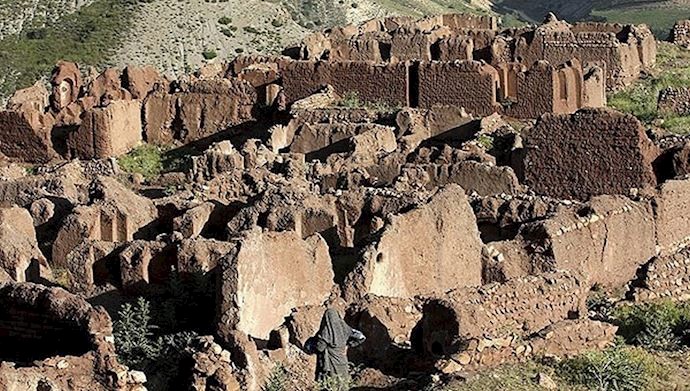Analysis by PMOI/MEK
Iran, September 26, 2019—As the revenue of families in Iranian villages continues to decrease, their livelihoods spiral into poverty and misery. A quick glance at the stats in this regard clearly shows the critical situation of rural life in Iran.
Iran’s economic growth in the current Persian year (March 2019-March 2020) has been -5.4 percent, and forecasts show that it will decline even further next year. Negative economic growth is not just a figure. The consequences in Iranian society is inflation, an increase of prices and further expansion of the divide between different social and economic classes.
Iranian workers and farmers and other unprivileged classes of the society, as well as the Iranian middle class, are the main victims of the economic disaster that results from the rule of the mullahs. Farmers in particular bear the main burden of the economic disarray in Iran. In the previous Persian calendar year, the average revenue of rural families declined by 12.6 percent.
Farmers are bound to their land and live off the revenue from their crops and agricultural produce. But government contractors never purchase agricultural produce at reasonable prices. Meanwhile, the government imports the same products from abroad and pours them into Iran’s markets. As a result, the products of Iranian farmers remain without buyers, and because of their debts and expenses, they’re forced to sell their produce at very low prices to the government or regime-backed contractors. In many cases, they don’t receive their payments immediately and are forced to accept payments in installments, which are often paid with much delay.
Therefore, in the current economic cycle, the main damage is dealt to farmers, who end up with more debt than their yearly revenue.
In the heat of infighting and factional rivalries, the regime’s state-run media sometime reveal previously undisclosed aspects of the miseries of Iranian farmers.
In August, Tasnim, a news website run by the terrorist-designated Revolutionary Guards (IRGC), quoted the CEO of the Rural Aid Organization as saying, “While the revenue from the agriculture sector is approximately 25-27 percent, given the increased inflation and the 18-percent bank interest, farmers have to pay 38 percent of their revenue in expenses, which is more than their gross profit. Under such circumstances, how can we expect the agriculture sector to have a profit margin and conduct long-lasting operations?”
Meanwhile, the government of Hassan Rouhani is fast busy looting farmers under the pretext of “self-sufficiency.” Depleting underground water resources and destroying farmlands are a few examples of the actions taken by the Iranian regime. The Iranian regime hasn’t even considered purchasing farming goods at their real prices for the sake of pretending to take concrete measures toward implementing the self-sufficiency plan.
Also noteworthy is the increasing costs of living, which has negatively affected the livelihoods of farmers in rural areas. According to an infographic published by the state-run ISNA news agency, in the past two years, the costs of living in villages has increased by 20 percent, making lives for farmers even harder.
Under such circumstances, low production and the inability to sell farming yields at decent prices only worsens an already-bad situation. Water shortages caused by the destructive environmental policies of the regime, lack of access to proper technology for plantation and harvesting, huge difference between salaries in rural and urban areas, and the general indifference of the Iranian regime toward life in rural areas has pushed many farmers to leave their villages and migrate to big cities. But they end up in miserable lives on the margins of urban areas, where they live in poverty and without their basic needs, and deprived of government services.
But the painful truth is that even if they stay on their dry farming lands, their situation won’t be any better. Under the tyrannical rule of the mullahs, there’s no expectation for fundamental changes to the lives of farmers. This national disaster manifests itself in the yearly migration of more than 700,000 farmers and villagers to the margins of cities. This migration is not a step toward a better life, but a desperate attempt for survival.
The 40 years of the mullahs’ rule is synonymous with an all-out massacre. From several hundred executions every night in Evin Prison and the massacre of political prisoners, to the massacre of the economy &production, environment, culture &art, and the #Iran ian civilization. pic.twitter.com/W1jmUtCAIO
— Maryam Rajavi (@Maryam_Rajavi) July 13, 2019
The result of 40 years of tyrannical rules by the mullahs in Iran, the looting of national resources and the squandering of the country’s wealth on foreign terrorism and proxy wars, reflects itself in the painful lives of Iranian farmers. Hopefully, with the overthrow of the mullahs’ regime, the farmers of Iran can once again hope for a better future for their children.





